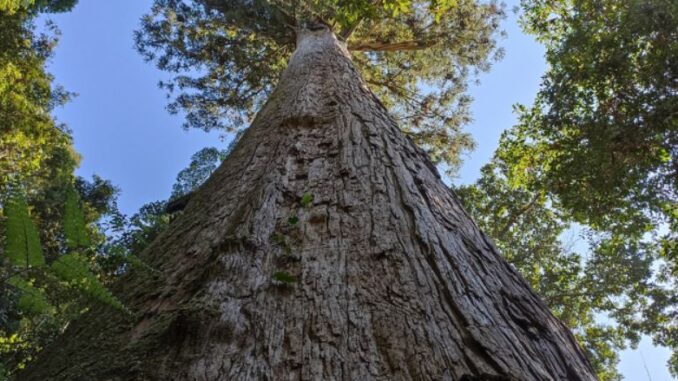
The population of samu and po mu in Xuan Lien nature reserve is considered the largest in the North Central region with many hundred-year-old trees, especially some nearly 1,500-year-old trees.
The rare wood population is located more than 180 km west of Thanh Hoa city center. To come here, from Vi village, Bat Mot commune, Thuong Xuan district, visitors need about three hours more trekking and must have forest rangers and indigenous people as pilots to help cross many streams and steep passes. elbows…
![[Caption] nbb mm](https://i1-vnexpress.vnecdn.net/2022/03/11/Sa-mu-1-5940-1646974586.jpg?w=680&h=0&q=100&dpr=1&fit=crop&s=lYG3saJ8ycEaXyIl24ftbw)
The tallest and oldest tree in Xuan Lien forest is the samu oil tree that lives at an altitude of about 1,400 m above sea level, bordering Vietnam and Laos. The tree’s scientific name is Cunninghamia konishii, also known as safflower oil, mahogany… belonging to the pine family. The tree stump has a diameter of nearly 4 m, the trunk is upright, about 70 m high. On the trunk, lichens grow green, covered.
The Samu tree was analyzed by experts and determined to be nearly 1,500 years old. In 2013, the tree was recognized by the Vietnam Association for the Protection of Nature and Environment as a Vietnamese heritage tree.
About 1.5 km from the samu oil tree, there is an ancient po mu tree, classified as a heritage tree in 2013. The tree living in the mountain is 1,300 m high above sea level, nearly 3 m in diameter, with a trunk. straight, about 60 m tall, bark gray-brown, with longitudinal cracks. Mature leaves grow in pairs of crosses, the wood has a mild fragrance… The tree was identified by Japanese experts as more than 1,000 years old.
According to Mr. Le Quang Dao, ranger of Van village, in the forest, besides the two trees recognized as heritage, there are about 35-40 other trees with a diameter of one meter or more, the age of less than 1,000. These large trees are mainly distributed from an altitude of 700 m or more, because of the high mountainous terrain and cool climate all year round, which are favorable conditions for the growth of conifers.
“Many domestic and foreign scientists have come here to study and evaluate the po mu and sa mu forests in Xuan Lien as one of the oldest conifer populations, the densest concentration in Vietnam. South is now and is considered as a treasure of Thanh Hoa,” said Mr. Dao.
![[Caption] nbb](https://i1-vnexpress.vnecdn.net/2022/03/11/Po-mu-1690-1646974586.jpg?w=680&h=0&q=100&dpr=1&fit=crop&s=fSk16SPKE0ZeS71wwKnAkw)
About 20 years ago, Thanh Hoa had a lot of endemic primeval forests, such as green iron , sen, po mu… However, when the “storm of loggers” swept over, the forests gradually disappeared. The po mu and sa mu trees in Xuan Lien have survived to this day, according to forest rangers, thanks to the drastic protection plan of the functional forces and the cooperation of the local people.
Mr. Lang Hong Tuyen, Party cell secretary and head of Vi village, said that the whole village has 180 households, mainly Thai people, all of whom consider the two-thousand-year-old trees to be “divine trees” and strictly protect them. “For hundreds of years, the villagers have lived on the forest. It is the primeval forests that are the source and source of water for daily life and cultivation, so we always remind each other to keep the forest as the source of our lives. me…”, Mr. Tuyen shared.
According to Mr. Nguyen Phu Thieu, Head of the Forest Protection Station of Vi village, since the forest protection group of Van village was established (elected by villagers to patrol, guard the forest together with rangers), especially the policy of contracting the forest. , payment for services, people’s awareness has changed, they feel responsible, attached to the forest.
“Van village forest is the most pristine and most abundant place in Xuan Lien,” said Mr. Thieu.
![[Caption]nnjj](https://i1-vnexpress.vnecdn.net/2022/03/11/IMG-20220123-102047-7589-1646974587.jpg?w=680&h=0&q=100&dpr=1&fit=crop&s=ayi3g5jKiv4tbptgEFS2zA)
Thanks to the protection of rare forests, the people of Van village now have the opportunity to find new livelihoods when community tourism and experience tourism are interested in investment. The People’s Committee of Thuong Xuan district has planned to build Van village into a community-based tourist destination combining discovery tourism in order to exploit existing strengths, towards green and sustainable tourism development.
Xuan Lien Nature Reserve was established in 1999, with a total area of more than 27,000 hectares, bordering Nghe An province and near the Vietnam – Laos border. This is one of the conservation areas with valuable biodiversity reserves of Vietnam with many species of flora and fauna listed in the Red Book of Vietnam and the world.
Follow (vnexpress)
